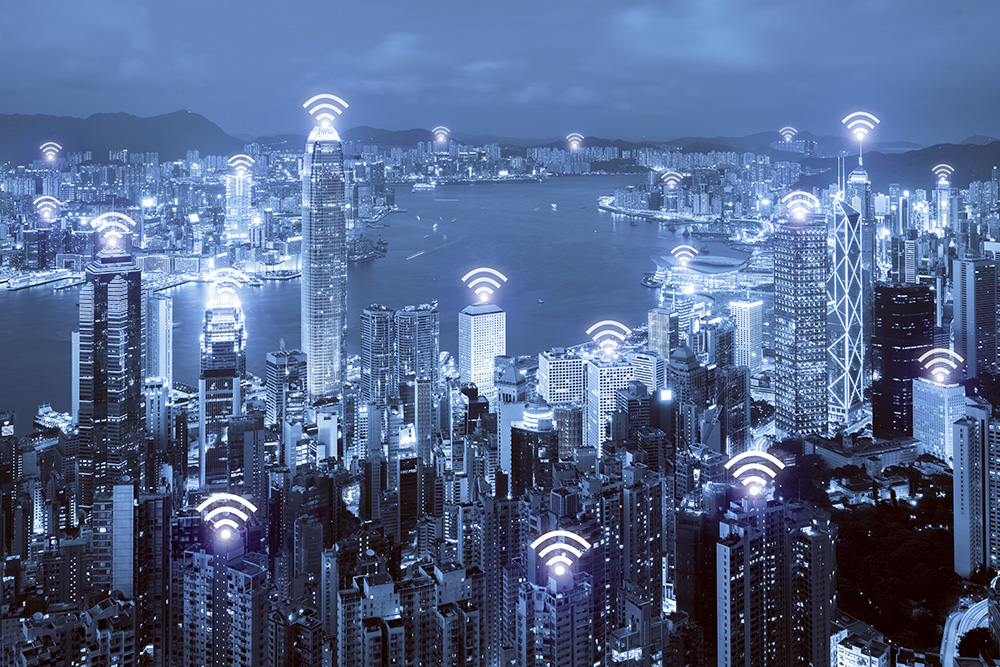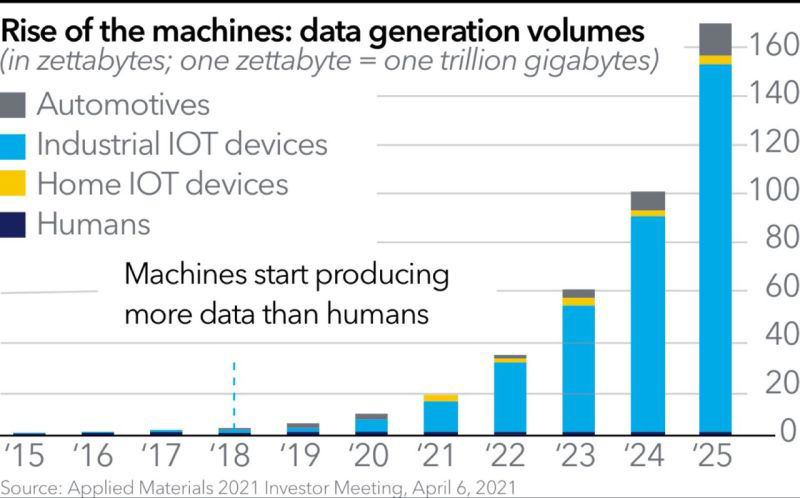What markets are driving demand for IoT and how big is IoT projected to get?
December 19, 2022 by Rich Kurtzman, Brand Communications @ Fathym

IoT, or the Internet of Things, isn’t going away anytime soon.
In fact, not only is it growing, but the data in which IoT produces is growing at an exponential rate.
We’re witnessing a data explosion as our world continues to become more and more interconnected every day.
Now, you can find a dinner recipe online, send the ingredients to your smart refrigerator, have the fridge tell you what food you need and then send that data to a personal shopping application.
That's just one possibility.
A simpler example is: There’s motion at your front door, your smart doorbell sends you an alert and you see a package arrived. An hour later, the security system alerts of more movement; Oh no! A package pirate has stolen your Christmas gift. Luckily, the camera caught the culprit’s face and you send that data to the local police department.
Our homes continue to become smarter, with Wi-Fi-connected devices including light bulbs, baby’s sound machine or the thermostat. Every one of those devices is sending data somewhere; that means the amount of data is ballooning quickly.
Data predicted to see 5x growth by 2025

According to Applied Materials in 2021, we can see data generation is projected to nearly double every year into 2025.
And pushing that data explosion will be automation and Industrial IoT or IIoT.
Back in May, we wrote about the United States looking to “onshore” manufacturing. That means bringing manufacturing back to America after many companies left to other countries with less stringent regulations.
Since that article was published, we’ve seen a ton of onshoring in the US.
Which markets are pushing IoT explosion?
Automotives
General Motors and Toyota are either expanding their manufacturing plants or building new ones for electric vehicles’ battery manufacturing. Ford, too, is investing half a trillion dollars into the electric vehicle sphere over the next five years.
Automakers were some of the first to widely utilize automation, reducing the number of human workers due to dangerous conditions on the floor of plants as well as efficiency gains by using robots.
Not only will automakers continue to refine the automation process of building their vehicles, they’ll also look to build their own batteries as cars and trucks go from burning fossil fuels to battery-powered in coming years.
Finally, the next step will be self-driving cars. That will mean additions of tens or even hundreds of IoT sensors per vehicle. Each one will be reading data and pushing it to the central computer of the car, or even up and into the cloud.
Tech industry and semiconductors
The tech industry has been seeing a major boom in their creation of semiconductor computer chips in America, too.
That was the goal of the CHIPS and Science Act, which has led to companies like Intel, Samsung and Micron building massive semiconductor plants.
Groundbreaking on Intel’s $20 billion plant came in September in Ohio. Samsung’s semiconductor plant in Texas will cost $17 billion while Micron’s Idaho plant will come in at $15B.
Those major investments will help keep the US on the cutting edge of the needed semiconductor market, and it will make sure America doesn’t fall behind like they did last year in the car market. Today’s cars and trucks have an average of 1,200 chips in them, and the shortage of chips forced automakers to shut down during the pandemic.
IoT Healthcare
One of the newest on the scene for IoT is healthcare.
In fact, Forbes projects the Internet of Healthcare Things to be a top-4 trend in 2023.
Throughout the COVID-19 pandemic, virtual, at-home doctor visits became commonplace. In the very near future, patients will be sent home from the hospital to rest and heal up from the comfort of their couch or bed. Devices will be sent home with the patients, and that data will be piped into the cloud where it can then be turned into charts and doctors/nurses can monitor patients remotely.
There will even been advancements in “wearables” or smartwatches, as you may know them. From monitoring your heartrate to sleep or “getting your steps,” there are many ways in which wearables and biometrics can help improve your health.
In the future, data from personal wearables will be pushed into the cloud alongside official healthcare devices which patients will have on loan from their hospital.
Smart homes
We touched on smart homes earlier – like your home security system – but there are many ways our homes can get even smarter.
Imagine every door in your house has a sensor to tell you when it’s open or closed. And when it is closed, whether or not the door is locked. That could alert your phone when you head to sleep, “Hey, the front door isn’t locked!”
How about a house where devices monitor which rooms have people inside of them? The smart house automatically increases light to an individual’s preference, pipes heat into that area at their desired temperature and draws the curtains for the person just how they like it.
What if your smart home, using AI and machine learning, could speak to you and carry-on conversations? Not just take commands, but act as a friend, or a confidant?
We may see it one day.
Smart cities
Take the idea of smart homes and expand it to smart cities.
Smart cities use interconnected sensors and the data is collected in the cloud, from where it can be analyzed from humans or computers (AI-ML).
The goal of smart cities is to provide a better way of life for people inside the city.
For instance, road sensors could gage traffic. That data could be sent into the cloud, analyzed by AI-ML, and then pushed into a mapping application, telling drivers to take an alternate route. It could even be specific to those particular drivers’ locations in the city, not a simple “Everyone take this route” which would result in another traffic slowdown.
In fact, some of this is already happening. Per TWI Global, Kansas City has implemented smart streetlights and San Diego has 3,200 sensors to optimize traffic flow and parking and much more.
Another example is weather sensors can monitor the heat in certain parts of cities, and then planners could take efforts to reduce the temperatures by using trees or other green areas.
The possibilities are nearly limitless and will likely change the way we live forever.
IoT sensor prices are dropping
Per Factmr.com: Also, the reduced cost of IoT sensors is one of the salient causes that are likely to fuel the market in the future.
Simply, the tech has finally caught up to our plans. Because sensors are so cheap, we can afford to use the greater numbers needed to monitor all kinds of data.
And as those sensors come online, the data produced will skyrocket.
Businesses aren’t using their IoT data effectively
According to an Inmarsat study from Feb. 2022, 86% of companies are saying they aren’t using their data well enough. Efficiently enough. Or effectively enough.
From the study, “The ultimate measure of an IoT project’s success is how it improves the way a company and its partner eco-system operates. This is largely resultant on the type of data extracted and how it is shared and turned into practical and actionable business insights in a timely manner.”
Simply, companies do not know how to convert their data to usable and manageable information, and at the same time, that data will only increase at a great rate from here.
IoT Ensemble is the solution
Fathym’s IoT Ensemble is an out-of-the-box cloud solution for all sizes of businesses.
Getting set up for the cloud takes expertise, time and resources. That’s why we’ve automated our IoT cloud best practices, so you can focus on your business and what you do best.
IoT Ensemble collects needed sensor and device data, allows users to create interfaces that are usable, interactive and valuable and allows people to make decisions off of that data.
As for the data and getting it into the cloud, IoT Ensemble handles all of the heavy lifting in Microsoft Azure. For the user, setting up your device, dashboards, and alerts is a much more manageable lift.
Of note, Fathym was named among top Colorado IoT companies in November.
IoT isn’t going away anytime soon. The world is getting smarter every day. As the great Ferris Bueller said, “Life moves pretty fast. If you don't stop and look around once in a while, you could miss it.”